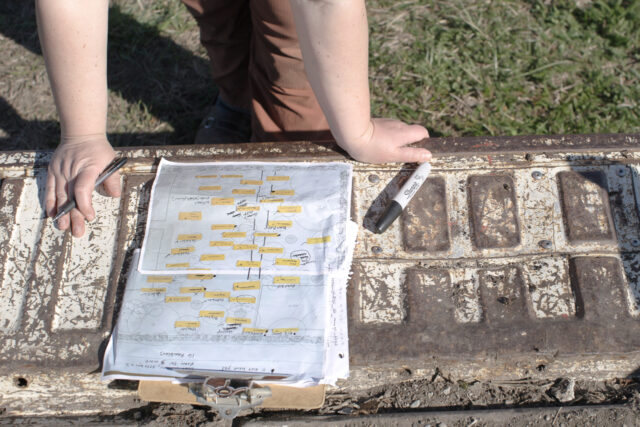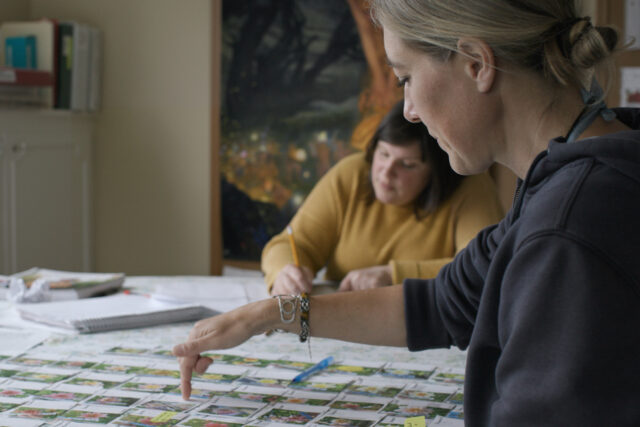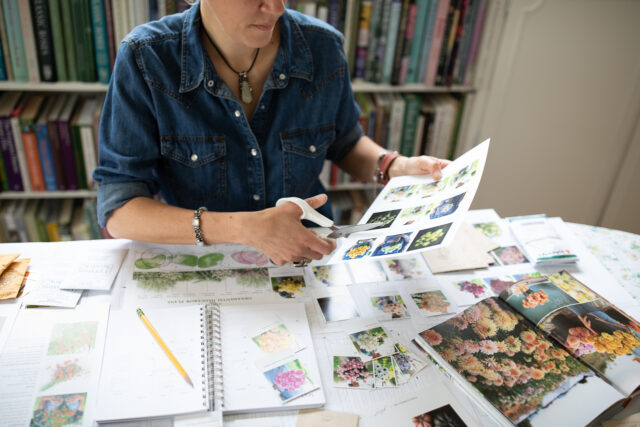Jill here. I use a lot of different types of supplies to help plan the farm each season and love stocking up before digging into the planning process—it’s a similar feeling to buying a fresh box of crayons before school starts. If you want to see the farm planning process in action, be sure to watch this video.
Below are all of the supplies I use on a regular basis. This is by far one of the dorkiest things I’ve ever written, but I have a surprising amount of things to say about office supplies, apparently enough to constitute an entire blog post!
Because I know fellow office supply enthusiasts will ask, I’ve also included specific links throughout.
Paper & Post-it Notes
For making project plans and outlining to-do lists, we love these easel pads which are essentially really large Post-it Notes. They adhere well to the walls or windows and are great to leave up as plans gel. They also make a gridded version which comes in handy for checklists (the boxes are built in) or anything that needs to be a little more presentation worthy. The large sheets are also great for sketching out sections of the garden or farm.
It’s kind of silly to get this excited about Post-it Notes, but the super sticky ones have been a total game changer and we use them for just about everything. The entire back has adhesive so they stay stuck without lifting over time. The larger 3×3 size is great for labeling the outside of bins or laminated maps. We also use a ton of the 2×2 size in bright colors. Both sizes can be cut down into smaller strips for labeling rows or individual plants on farm drawings or maps.
When we need to create our own maps, or a template for a field block, large 11×17 graph paper works really well. We prefer the pads over the loose sheets because they’re easier to carry around and store away.
You’ll never see Erin without a spiral notebook in hand—she can burn through an entire 5-subject in a month! We buy loads of these each year and like Five Star for the thicker paper and the manila pocket dividers.
We’ve found that legal pads are far superior (and much less cumbersome than a 5 subject notebook) when taking notes and writing descriptions in the field. The cardboard back protects the pages if you set them down in the wet grass (or leave them overnight on the seat of the buggy) and they also fit well on a clipboard.
For field notes, we use an app called Genius Scan which will convert a photo into a PDF that can be emailed and transcribed later. We use it all the time to email notes to each other.
 Pens
Pens
Pilot brand is our favorite all-around pen. At the beginning of the season, we buy a big multi-pack with black, blue, and red (which is great for text editing). They are really inky and smooth so you can write fast. We like the G2 10, but if you like a finer point, go for the G2 07. They will smear when wet, so if it’s sprinkling outside when you’re taking notes, opt for a regular ballpoint pen.
An ode to Sharpie! There are so many choices when it comes to this simple black pen—let me count the ways!
The Ultra Fine Point is really nice for more precise labeling projects. Regular Sharpies are great for everyday use, for writing on flagging tape, and the Tyvek “toe tags” we use to label our flysolations.
For signage you need to see from a distance (like our greenhouse and hoop placards), I prefer the Chisel Tip because it’s bold and easy to read. And for writing on the 12-in plastic Macore field stakes, I’m partial to the Super Sharpie. The larger size is more comfortable when writing hundreds (even thousands!) of labels, and the ink holds up well over the growing season. Plus, something about this pen makes your handwriting look extra nice.
Sharpie also makes a non-permanent flip chart marker that works well on the easel pads. They are available in a multi-colored pack. I love these markers—nothing better than a good inky pen!
 Other supplies
Other supplies
Washi tape is a lightweight masking tape that’s popular in the crafting world. It’s available in a ton of colors (and even patterns) in wide and narrow widths. It lifts off easily, so it comes in handy if you need to move things around. The narrow version works well for indicating longer-range projects on a paper calendar to see how they overlap with one another.
The year we wrote A Year in Flowers and Discovering Dahlias we decided to invest in a really nice color printer so we could print design inspiration and page mockups in-house. We keep the Xerox humming and use it for everything—printing phone photos, web page mock-ups, and planning cards so we can plant crops in color order, of course!
Everyone gives me a hard time for my dorky Trapper Keeper-style binders. When we were documenting hundreds of the dahlia breeding varieties, I used these full zip binders to hold each variety’s profile sheet, with paper dividers for each row. They were so stout that I could prop them up on a T-post to write notes. Some even come with an optional shoulder strap for added cool factor.
Another great binder for note-taking is this refillable notebook. It flips back completely for a flat writing surface and comes in lots of colors if you want a different one for each crop you’re documenting.
For cutting cardstock or lots of paper, it’s nice to have a paper cutter. Make sure you’re paying full attention and be mindful of the blade (that’s why I like this one with a handle). Paper slicing is likely the only job hazard you’ll encounter when farm planning.
If you use pencils or colored pencils for planning, get a good electric sharpener. They also work well for the grease marking pencils we use with our metal labels for more permanent crops we have on the farm.
 Basic office supplies
Basic office supplies
You likely already have these at home, but for planning it’s good to have glue sticks, clear matte tape, and a good ruler (I like the clear plastic ones).
Sharp scissors are also a must. Keep a pair for paper and if you make a lot of bouquets, designate a pair for ribbon only by tying a piece around the handle. However, if you have kids, they will likely still ignore it!
You’ll always be reaching for sharp #2 pencils. A retractable eraser stick is a pretty handy tool that won’t leave an annoying smudge.
I hope this little post was helpful and gave you a laugh. If you have a favorite supply you use to plan your garden or farm that’s not included above, tell us about it in the comments section below.
Please note: If your comment doesn’t show up right away, sit tight; we have a spam filter that requires us to approve comments before they are published.
Floret only lists companies and products that we love, use, and recommend. All opinions expressed here are our own and Floret does not offer sponsored content or accept money for editorial reviews. If you buy something using the retail links in this post, Floret may receive a small commission. Thank you for your support!
